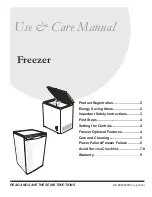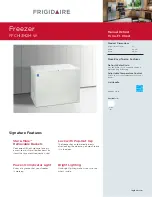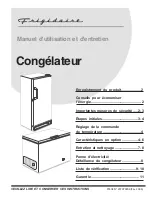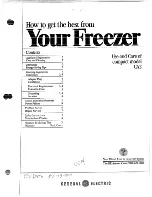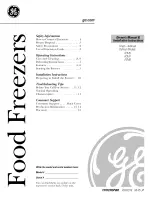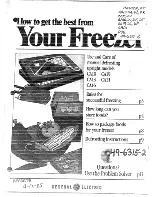
13
Defrosting
Refrigerator
Frost is automatically removed from the evaporator of the refrigerator com-
partment every time the motor compressor stops, during normal use. The
defrost water drains out through a trough into a special container at the
back of the appliance, located over the motor compressor, where it evapo-
rates.
Freezer
The freezer compartment, however, will become progressively covered with
frost. This should be removed with the special plastic scraper provided,
whenever the thickness of the frost exceeds 4 mm. During this operation it
is not necessary to switch off the power supply or to remove the foodstuffs.
However when the ice becomes very thick on the inner liner, complete
defrosting should be carried out as follows:
1.
Remove the frozen food from the freezer, wrap it in several layers of new-
spaper and put it in a very cool place.
2.
Switch off the appliance and pull out the plug, or turn the temperature
control knob to “0”.
3.
Leave the freezer compartment door open.
4.
Insert the plastic scraper into the
recess provided under the defrost
water channel and place a collecting
basin under it.
5.
Once defrosting is completed keep
the scraper handy for future use;
6.
Turn the thermostat knob to the
required setting or replace the plug
in the power socket.
Warning!
Never use metal tools to scrape off
the frost
Do not use a mechanical device or any artificial means to speed up the
thawing process other than those recommended by the manufacturer.
A temperature rise of the frozen food packs, during defrosting, may shor-
ten their safe storage life.
D068
16
The compressor starts after a
period of time.
See the "Cleaning and Care"
section.
This is normal, no error has
occurred.
The compressor does not start
immediately after changing
the temperature setting.
Water on the floor or on sto-
rage shelves.
Water drain hole is blocked.
Heavy build up of frost, possi-
bly also on the door seal.
Door seal is not air tight (pos-
sibly after reversing the door).
Carefully warm the leaking
sections of the door seal with
a hair dryer (not hotter than
approx. 50 °C). At the same
time shape the warmed door
seal by hand until it sits cor-
rectly.
The food is too warm.
Interior lighting does not work.
The appliance is near a heat
source.
Temperature is not properly
adjusted.
Please look in the "Initial Start
Up" section.
Light bulb is defective.
Please look in the "Changing
the Light Bulb" section.
Turn the temperature control
knob to a colder setting.
Door was open for an exten-
ded period.
Please look in the "Installation
location" section.
A large quantity of warm food
was placed in the appliance
within the last 24 hours.
Open the door only as long as
necessary.
Symptom
Possible Cause
Remedy
Appliance does not work.
Appliance is not switched on
Switch on the appliance.
Mains plug is not plugged in
or is loose.
Insert mains plug.
Fuse has blown or is defective.
Check fuse, replace if neces-
sary.
Socket is defective.
Mains malfunctions are to be
corrected by an electrician.
Appliance cools too much.
Temperature is set too cold.
Turn the temperature control
knob to a warmer setting.
If, after carrying out the necessary checks there is still a fault with your
appliance please contact your local AEG Service Force Centre.
In guarantee customers should ensure that the suggested checks have
been made as the engineer will make a charge if the fault is not a
mechanical or electrical breakdown.
Please note that proof of purchase is required for any in-guarantee service
calls.






























